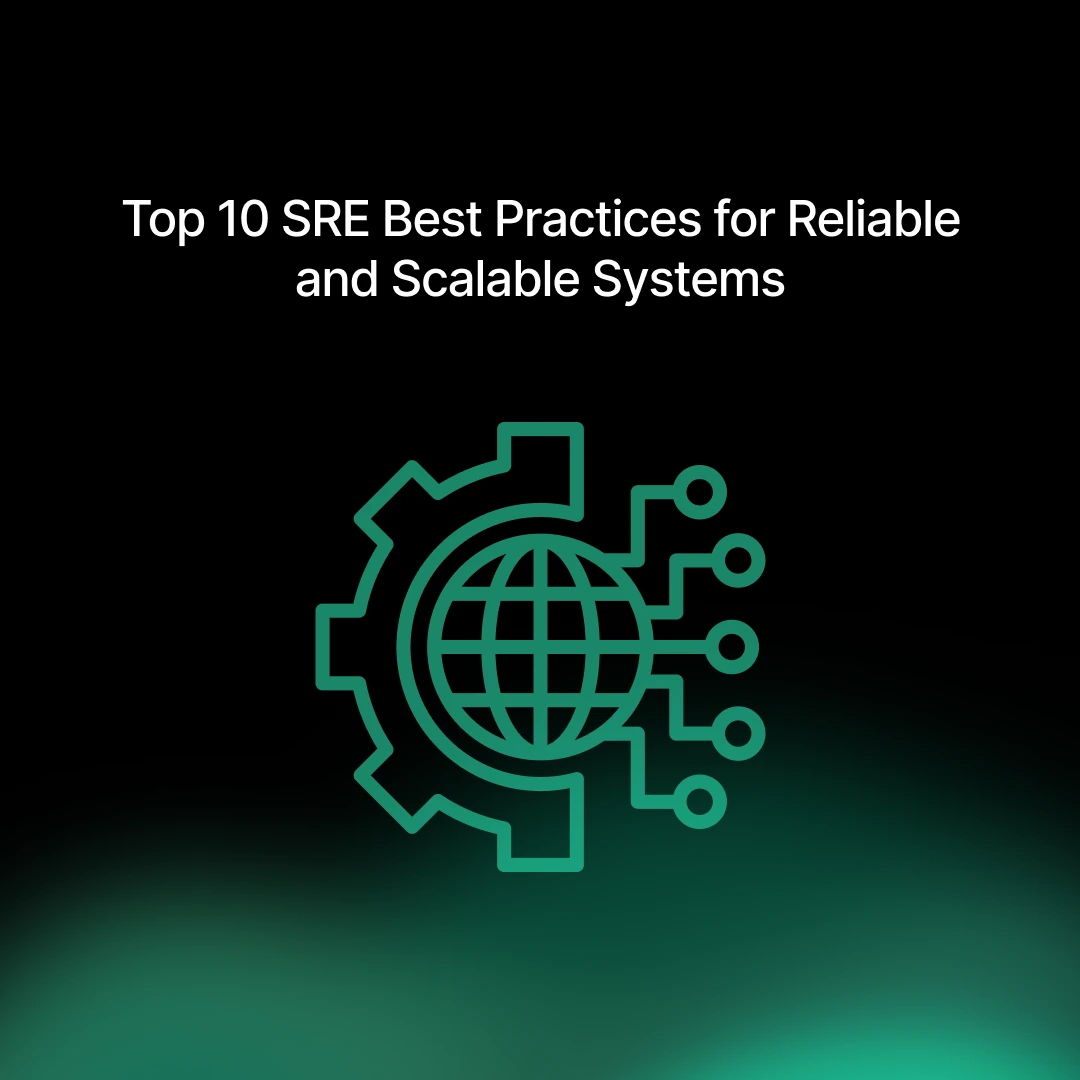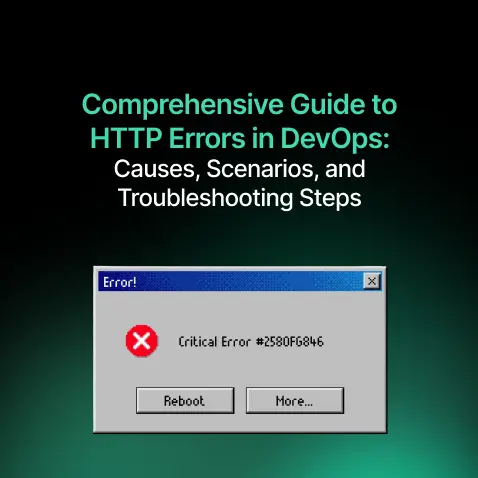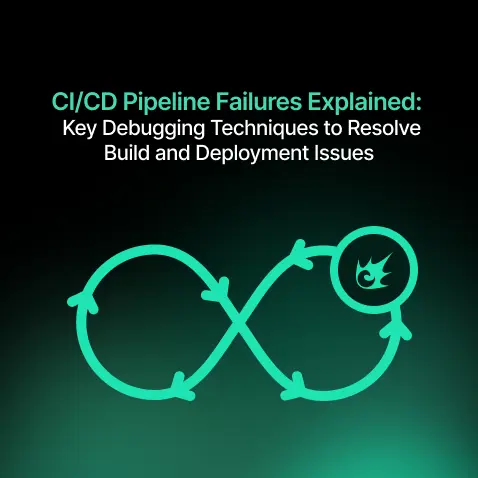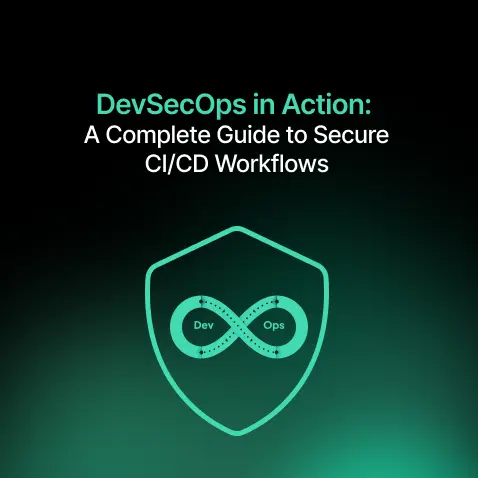Top 10 SRE Best Practices for Reliable and Scalable Systems
- Nitin Yadav
- Knowledge
About

Site Reliability Engineering (SRE) represents a transformative approach to managing system reliability and performance.
Industries
- AWS, SRE
Share Via
Introduction
Site Reliability Engineering (SRE) has emerged as a critical discipline for organizations striving to achieve reliability, scalability, and operational excellence in their IT systems. Born at Google and now adopted by enterprises worldwide, SRE combines software engineering principles with IT operations to create systems that are robust and dependable. This article explores the top 10 best practices in SRE, providing a comprehensive guide for organizations looking to build and maintain reliable systems.
What is Site Reliability Engineering?
Site Reliability Engineering (SRE) is a discipline that originated at Google in the early 2000s to bridge the gap between development and operations. The primary goal of SRE is to enhance the reliability, performance, and scalability of systems through automation and software-driven solutions.
Top 10 SRE Best Practices
1. Define and Measure Service Level Objectives (SLOs)
SLOs are at the heart of SRE. They define the acceptable performance and availability thresholds for a service. By clearly outlining SLOs, organizations can align operational priorities with business goals.
Key Steps:
- Identify critical user journeys to define SLOs that matter to customers.
- Use metrics such as latency, uptime, and error rate to quantify SLOs.
- Regularly review and update SLOs to reflect evolving user expectations.
Pro Tip: Use Service Level Indicators (SLIs) to measure how well your services meet the defined SLOs, and make this data accessible to all stakeholders.
2. Implement Error Budgets
Error budgets balance innovation with reliability by providing a calculated allowance for downtime or errors. This approach ensures teams can make informed trade-offs between stability and releasing new features.
How It Works:
- If the SLO for uptime is 99.9%, the error budget is 0.1% downtime.
- Teams can use this budget to assess whether to focus on reliability improvements or product development.
- Exhausting the error budget should trigger a pause in feature releases until reliability issues are resolved.
Benefits:
- Encourages a collaborative culture between developers and operations teams.
- Prioritizes fixes over new features when necessary, preventing excessive downtime.
3. Automate Everything Possible
Automation reduces manual intervention, minimizes errors, and accelerates responses to incidents. SRE teams should strive to automate as many tasks as possible.
Automation Opportunities:
- Incident Response: Use automated runbooks to handle recurring incidents.
- Monitoring and Alerts: Implement tools like Prometheus or Datadog to automate system monitoring.
- Infrastructure Management: Employ Infrastructure as Code (IaC) tools like Terraform or Ansible to standardize and automate resource provisioning.
Pro Tip: Focus on automating toil—manual, repetitive tasks that don’t add long-term value to the system.
4. Build Robust Incident Management Processes
Efficient incident management is critical to reducing downtime and maintaining user trust. SRE teams must establish clear protocols for handling incidents.
Best Practices:
- Incident Detection: Set up real-time monitoring and alerting to identify issues early.
- Incident Response: Create detailed runbooks to guide responses to common incidents.
- Post-Incident Reviews: Conduct blameless postmortems to identify root causes and prevent recurrence.
Tools to Use:
- PagerDuty or Opsgenie for incident alerting and response.
- Jira or ServiceNow for incident tracking and documentation.
5. Foster a Blameless Culture
A blameless culture encourages open communication and learning from failures without fear of retribution. This mindset is essential for effective incident management and continuous improvement.
How to Implement:
- Avoid pointing fingers during incident reviews.
- Focus on the systemic causes of failures rather than individual mistakes.
- Celebrate successful resolutions and lessons learned.
Why It Matters:
- Encourages transparency and accountability.
- Improves team morale and fosters collaboration.
6. Invest in Observability and Monitoring
Observability enables teams to understand system behavior and troubleshoot issues effectively. Unlike traditional monitoring, which focuses on predefined metrics, observability provides deep insights into system performance.
Key Practices:
- Implement Distributed Tracing: Use tools like Jaeger or Zipkin to trace requests across microservices.
- Centralize Logging: Aggregate logs using platforms like ELK Stack or Splunk for easier analysis.
- Adopt Dashboards: Use Grafana or similar tools to visualize system health in real time.
Pro Tip: Combine logs, metrics, and traces to get a comprehensive view of system performance.
7. Focus on Scalability
SRE teams must design systems that can handle increased loads without degrading performance. Scalability ensures the system remains reliable as user demands grow.
Scalability Strategies:
- Use horizontal scaling to add more servers or instances as needed.
- Optimize database queries and caching to reduce bottlenecks.
- Adopt container orchestration tools like Kubernetes to manage workloads efficiently.
Pro Tip: Perform regular load testing to identify potential scalability issues before they impact users.
8. Manage Configuration and Infrastructure as Code (IaC)
IaC ensures that infrastructure configurations are version-controlled and repeatable, reducing the risk of errors and drift.
Best Practices:
- Use tools like Terraform or Pulumi to define infrastructure.
- Store configurations in version control systems like Git.
- Implement code reviews for configuration changes to catch issues early.
Pro Tip: Treat your infrastructure code with the same rigor as application code, including testing and peer reviews.
9. Prioritize Security
Security is a critical aspect of reliability. SRE teams must integrate security best practices into their workflows to protect systems from vulnerabilities.
Security Practices:
- Use automated security scans to detect vulnerabilities in code and configurations.
- Implement role-based access control (RBAC) to limit permissions.
- Encrypt sensitive data in transit and at rest.
Pro Tip: Regularly review and update security policies to address emerging threats.
10. Continuously Improve Through Feedback Loops
Continuous improvement is a cornerstone of SRE. Teams should regularly evaluate their practices and incorporate feedback to enhance reliability.
How to Implement:
- Use incident reviews to identify process improvements.
- Collect feedback from stakeholders and end users.
- Monitor performance metrics to track progress over time.
Pro Tip: Set up quarterly reviews to assess SLOs, error budgets, and other key metrics, ensuring alignment with business goals.
Conclusion
Implementing these top 10 SRE best practices can transform your organization’s approach to reliability and scalability. By focusing on automation, observability, and continuous improvement, SRE teams can ensure their systems meet user expectations and support business growth. Start adopting these practices today to build resilient systems that stand the test of time.
Frequently asked questions
SRE is a discipline that applies software engineering principles to IT operations, focusing on building reliable, scalable, and efficient systems.
Service Level Objectives (SLOs) help define acceptable performance thresholds, ensuring alignment between business goals and operational priorities.
An error budget quantifies the acceptable level of downtime or errors, helping teams balance innovation and reliability effectively.
Automation reduces manual errors, accelerates incident response, and eliminates repetitive tasks, enhancing system reliability and efficiency.
A blameless culture encourages open communication and focuses on learning from failures rather than assigning blame, fostering collaboration and trust.
Popular tools include Grafana for dashboards, ELK Stack for centralized logging, and Jaeger or Zipkin for distributed tracing.
SRE teams use horizontal scaling, caching, and tools like Kubernetes to handle increasing user demands without performance degradation.
IaC ensures infrastructure configurations are version-controlled, repeatable, and free from errors, supporting consistency and scalability.
SRE integrates automated security scans, role-based access controls, and encryption to protect systems and maintain reliability.
Continuous improvement involves regular feedback loops, incident reviews, and performance monitoring to refine practices and enhance reliability.
Related Posts

Comprehensive Guide to HTTP Errors in DevOps: Causes, Scenarios, and Troubleshooting Steps
- Blog

Trivy: The Ultimate Open-Source Tool for Container Vulnerability Scanning and SBOM Generation
- Blog

Prometheus and Grafana Explained: Monitoring and Visualizing Kubernetes Metrics Like a Pro
- Blog

CI/CD Pipeline Failures Explained: Key Debugging Techniques to Resolve Build and Deployment Issues
- Blog

DevSecOps in Action: A Complete Guide to Secure CI/CD Workflows
- Blog

AWS WAF Explained: Protect Your APIs with Smart Rate Limiting
- Blog

